Last Updated on May 23, 2025 by Kittredge Cherry
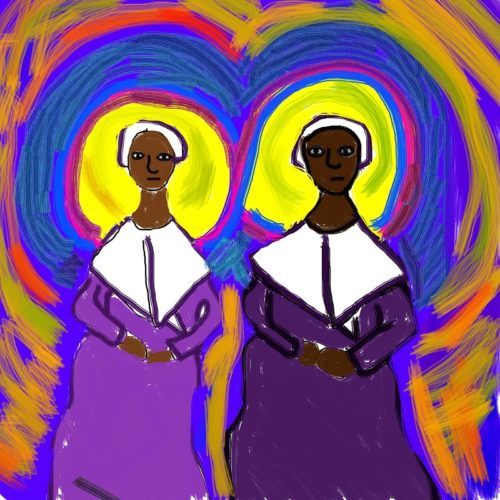
Preacher Rebecca Cox Jackson and her longtime companion Rebecca Perot were queer African American women who founded a Shaker religious community in Philadelphia in the 1800s. Known as “the two Rebeccas,” they lived together as ministry partners for more than 30 years in a covenanted relationship that has been described as lesbian, womanist, queer and/or celibate. Jackson’s journal is considered the first black queer spiritual narrative in American history. Rebecca Cox Jackson died at age 76 on May 24, 1871.
Their Philadelphia Shaker community, comprised mostly of black women, continued for decades. And yet their lives and contributions are little known except to scholars.
Q Spirit is proud to add the first-ever image of Rebecca Cox Jackson to the top of this post: “The Two Rebeccas” by Jeremy Whitner. There are no known photos of Jackson, but Whitner gives her visual form in a colorful 2021 icon that pairs her with her beloved partner. Their haloes are linked by an infinity knot with an endless loop that may symbolize eternity, faith, wisdom and love. Whitner is a gay Christian mystic in process for ministry with the Disciples of Christ.
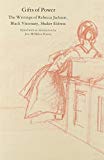 Jackson’s spiritual autobiography records her own extraordinary life story and both of their dreams, which often revolved around each other in ways that were sometimes mildly homoerotic. For example, Perot dreamed that Jackson was crowned king of Africa while she was crowned queen. Jackson dreamed of Perot walking in a river and “she had on only her undergarment. She was pure and clean, even as the water in which she was abathing.”
Jackson’s spiritual autobiography records her own extraordinary life story and both of their dreams, which often revolved around each other in ways that were sometimes mildly homoerotic. For example, Perot dreamed that Jackson was crowned king of Africa while she was crowned queen. Jackson dreamed of Perot walking in a river and “she had on only her undergarment. She was pure and clean, even as the water in which she was abathing.”
These two unconventional women of God stayed together until Jackson died in 1871. Then Perot adopted the name of her beloved friend and mentor. She became known as “Mother Rebecca Jackson” and assumed leadership of the Philadelphia communal family.
Jackson’s manuscripts were buried in archives for about a century until they were rediscovered and published in 1981 as “Gifts of Power: The Writings of Rebecca Jackson, Black Visionary, Shaker Eldress,” edited by women’s studies professor Jean McMahon Humez. In her introduction, Humez wrote this about Jackson:
“After breaking with her husband and father, she lived and traveled throughout the rest of her life in a close relationship with a single, cherished, intimate woman friend who shared her religious ideas. Perhaps, had she been born in the modern age, she would have been an open lesbian.”
The mystical queer eroticism in Jackson’s spiritual autobiography “Gifts of Power” is explored by Oberlin College religion professor Margaret Kamitsuka in light of writings by French lesbian feminist thinker Monique Wittig in the book “Desirable Belief: A Theology of Eros” (Fortress Press, 2024).
Regardless of whether the two Rebeccas were lesbians, their defiance of gender norms and theology of gender equality are vital to women and LGBTQ people today. The two Rebeccas provide an inspiring role model for LGBTQ people of faith because they followed their religious calling despite opposition from church and family.
Jackson had dramatic religious awakening at age 35
Jackson was born Feb. 15, 1795, to a free black family that was active in the African Methodist Episcopal (AME) Church in Philadelphia. When she was 13, her mother died and she was taken in by her widowed older brother, an AME minister. She helped him raise his six children and married Samuel Jackson, but she remained childless. Like many black women of her era, she earned her living as a seamstress.
Rebecca Perot was born July 10, 1818, which makes her 23 years younger than Jackson.
Jackson experienced a dramatic religious awakening at age 35 during a severe thunderstorm in July 1830. She was terrified by thunderstorms, and while the storm raged she prayed for either death or redemption. Suddenly she felt as though “the cloud burst.” Lightning that used to be “the messenger of death, was now the messenger of peace, joy, and consolation.”
Through this revelation she received what she called the “gift of power.” She shifted from being a member of a religious family to becoming a prophetic religious activist in her own right. She discovered the presence of a divine “inner voice” and insisted on absolute obedience to its instructions, even when it brought her into conflicts with church and family. She went on to minister before, during and after the Civil War brought freedom to enslaved black people.
As part of her transformation, Jackson joyfully received a variety of new spiritual gifts. The most unusual one was the spiritual gift of literacy. Previously illiterate, she prayed for God to teach her to read and write — and God did! She also considered it a gift when she was freed of sexual desire for her husband. She began promoting the radical idea of celibacy even in marriage.
Following her inner voice led to church conflict
Guided by her inner voice, Jackson began sharing her spiritual visions, first at neighborhood prayer meetings in local homes, and then on preaching tours. She moved beyond male-dominated, Bible-based African Methodist Episcopal church to a more female-centered theology based on her own spiritual experiences. Jackson was so charismatic that she developed a large following of both blacks and whites. Most of her followers were women, but she was harshly criticized for “aleading the men” and refusing to officially join any church.
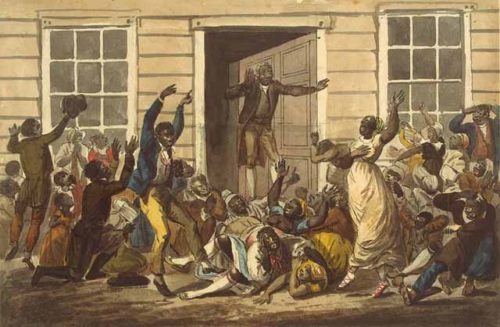
A black Methodist prayer meeting is shown in an 1811 watercolor painting by John Lewis Krimmel. (pbs.org)
Soon her new religious beliefs and activities led to the end of her marriage and separation from her brother. She became an itinerant preacher, traveling for 10 years in the late 1830s and early 1840s around Pennsylvania, northern Delaware, New Jersey, southern New England and New York. Her ideas remained so controversial that some pastors threatened to excommunicate members who let her stay in their homes.
Like many preachers of her time, Jackson’s authority came from her spiritual visions and her ability to communicate them. This inner authority seems especially important for queer religious leaders, who have to overcome expectations about their gender identity and sexual orientation. Another example is Jemima Wilkinson, a queer Quaker preacher in colonial America.
Other close female couples with homoerotic aspects in 19th-century America include the African American pair documented in “Beloved Sisters and Loving Friends: Letters from Rebecca Primus of Royal Oak, Maryland, and Addie Brown of Hartford, Connecticut, 1854–1868,” edited by Farah Jasmine Griffin, and the pious seamstresses Charity Bryant and Sylvia Drake documented in “Charity and Sylvia: A Same-Sex Marriage in Early America” by Rechel Hope Cleves.
Joining the Shakers, a religion with queer ideas
It was during her decade as a travelling preacher that Jackson joined forces with Perot and discovered how much she had in common with the Shakers. Like Jackson, the Shakers saw God as both male and female, supported gender and racial equality, and advocated celibacy. They emphasized direct experience of God leading to spiritual gifts.
 One of the few queer scholars to research on the Shakers is Elizabeth Freeman. She finds that Shakers used dance “to counter heteromarital hegemony” in a chapter called “Shake It Off: The Physiopolitics of Shaker Dance, 1774-1856” in her 2019 book “Beside You in Time: Sense Methods and Queer Sociabilities in the American 19th Century.” She explains: “Avoiding the rules that governed secular dance, which usually focused on partnering men and women, Shaker dance could serve to critique gender inequality and what might be called not just compulsory heterosexuality but compulsory sexuality.”
One of the few queer scholars to research on the Shakers is Elizabeth Freeman. She finds that Shakers used dance “to counter heteromarital hegemony” in a chapter called “Shake It Off: The Physiopolitics of Shaker Dance, 1774-1856” in her 2019 book “Beside You in Time: Sense Methods and Queer Sociabilities in the American 19th Century.” She explains: “Avoiding the rules that governed secular dance, which usually focused on partnering men and women, Shaker dance could serve to critique gender inequality and what might be called not just compulsory heterosexuality but compulsory sexuality.”
The Shaker belief in celibacy and gender equality must have made them a magnet for sexual minorities. They lived in communal dwellings with members of the same sex, sharing all property in common. Their radical idea of gender equality extended to the belief that their founder, Ann Lee, was the female counterpart of Jesus, the incarnation of the second coming of Christ.
Shaker life was homosocial if not homosexual. When they spoke of celibacy, did they mean abstinence from all sexual expression or just heterosexual intercourse and procreation? “Sodomy” was often defined as only sexual intercourse between men, as if sexual activity between women did not count. Perhaps celibacy was the same in the minds of some.
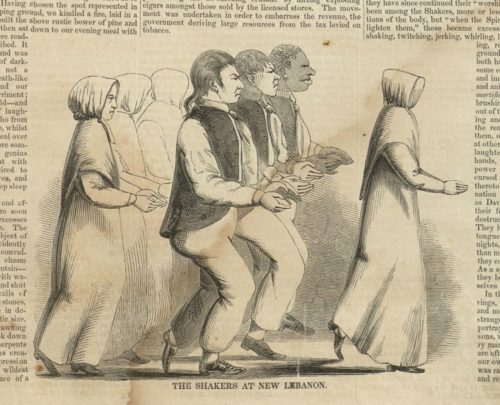
This drawing shows a racially integrated group of Shakers dancing in same-sex rows.
The Shakers were an offshoot of the Quakers. They called themselves the United Society of Believers in Christ’s Second Appearing, but others called them the “Shaking Quakers” or Shakers because they worshiped with ecstatic shaking and dancing in groups. The Shakers are one of the most important and long-lasting of the many religious utopian movements popular 19th-century America. They are widely appreciated for the austere beauty of their furniture design and for their worship song “Simple Gifts,” whose melody is included in the orchestral suite “Appalachian Spring” by Aaron Copland and the hymn “Lord of the Dance.”
Together the two Rebeccas joined the predominantly white Shaker community at Watervliet, New York, in 1847. The Shakers welcomed Jackson as a prophet and “eldress” and the two Rebeccas lived there for four years.
In this period the Shakers were at their height, with 6,000 members in 19 communal villages from New York and New England to Ohio, Indiana, and Kentucky. The 1840s were also an exciting period for African American women, with Harriet Tubman escaping slavery and Sojourner Truth beginning to speak for abolition.
But the two Rebeccas were frustrated by the Shakers’ lack of outreach to black people, so they left to found an unauthorized community of black Shakers in Philadelphia in 1851. After six years, they went back to Watervliet for a year, finding reconciliation and gaining financial support to establish an official Shaker “outfamily” in Philadelphia.
In 1859, shortly before the Civil War, the two Rebeccas founded the Philadelphia Shaker community. It combined Shaker theology with black female praying band traditions. About a dozen to 20 members, mostly black and female. Sources say they lived in rental spaces, including a large house at 724 Erie Street and a townhouse at 522 S. 10th Street. They also hosted worship services for other black Shakers in the area. It was unique among the Shakers because it was an urban community, while all the others were farming communities.
It’s not surprising that the Rebeccas chose Philadelphia as the home for their black Shaker community. Philadelphia was “the Harlem of early America,” according to historian Richard Newman in the documentary “Many Rivers to Cross.” He described it as the place where black people went for culture, jobs and community. The African Methodist Episcopal Church, America’s first and largest African American denomination, was founded in Philadelphia in 1816.
Were they lesbian, womanist, queer, celibate?
The relationship between the two Rebeccas is hard to define, so naturally debate has arisen about whether to call them lesbians. The two Rebeccas are highlighted in some lesbian resources, such as the book “To Believe in Women: What Lesbians Have Done for America – A History” by Lillian Faderman.
Among those who question the lesbian label is African American author Alice Walker. In her 1981 essay “Gifts of Power: The Writings of Rebecca Jackson,” Walker writes:
“What I am questioning is a nonblack scholar’s attempt to label something lesbian that the black woman in question has not. Even if Rebecca Jackson and Rebecca Perot WERE erotically bound, what was their own word for it? … I think we should at least wonder whether they would accept [the lesbian label] now, particularly since the name they DID accept and EMBRACE, which caused them so much suffering and abuse, was CELIBATE. Of course celibates, like lesbians, have a hard time proving they exist… My own term for such women would be ‘womanist.’”
This is one of the first-ever uses of the now-popular word “womanist,” which was coined by Walker. Since then the term she chose for the two Rebeccas has come to mean “black feminist” and led to the development of womanist theology. Walker’s essay on Jackson is included in “The Womanist Reader: The First Quarter Century of Womanist Thought,” edited by Layli Phillips.
 As LGBTQ language evolves, so does the terminology applied to the two Rebeccas. Scholar Marlon Rachquel Moore described them with the newer term “queer” in her 2006 book “In the Life and in the Spirit: Homoerotic Spirituality in African American Literature.” She writes:
As LGBTQ language evolves, so does the terminology applied to the two Rebeccas. Scholar Marlon Rachquel Moore described them with the newer term “queer” in her 2006 book “In the Life and in the Spirit: Homoerotic Spirituality in African American Literature.” She writes:
“Jackson’s spirit narrative is the earliest example of black queer spirituality because it provides “a radical questioning of social and cultural norms, notions of gender, reproductive sexuality and the family” (Smyth, 42). A queer analysis props open the window of possibility that Jackson’s withdrawal from heterosexuality may have other, perhaps unnarratable, implications and outcomes than a life of celibacy — some of which are channeled into her psychic landscape.”
Walker and Moore each discuss how the two Rebeccas might qualify as lesbian or queer, even if they abstained from sex. As Moore wrote, “Sexuality is not limited to genital contact and definitely does not begin with it. Sexuality involves attraction, fantasy, vibrational connection, and impulses that can occur before, during, after or INSTEAD OF physical contact.”
A section on Rebecca Jackson is included in “The Creation of Feminist Consciousness: From the Middle Ages to 1870” by Gerda Lerner, history professor at the University of Wisconsin in Madison. It was published by Oxford University Press in 1993.
Legacy of the two Rebeccas
After her awakening, Jackson spent the rest of her life continually trying to improve herself and society through her many spiritual gifts. As she wrote about the gift of reading, “Oh how thankful I feel for this unspeakable gift of Almighty God to me! Oh may I make a good use of it all the days of my life!”
She died of stroke at age 76 on May 24, 1871 and was buried in a Shaker community in New Lebanon, New York. Later her grave was moved to Eden Cemetery, an African American cemetery near Philadelphia.
The older Rebecca was gone, so the remaining Rebecca made the unusual decision to adopt the name of her beloved companion. The two Rebeccas became one. Under her leadership, their black Shaker community lived on for more than 25 more years.
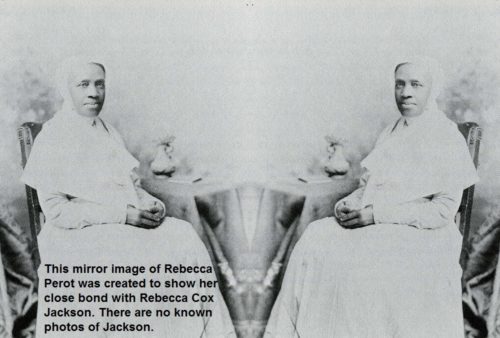
Photo of Rebecca Perot as a mirror image. There are no known photos of Rebecca Cox Jackson, so Q Spirit created this double image of the two Rebeccas. The mirror image makes visible their close bond and how their identities merged when Perot assumed Jackson’s name after her death.
In 1896 the community disbanded and Perot retired to Watervliet with three other elderly sisters in faith: Leah Collins, Alice Sharp, and Harriet Ann Jones. That same year W.E.B. DuBois, the leading African American intellectual of the time, found two Shaker households in his pioneering study of black Philadelphia.
Perot died at age 82 on Jan. 6, 1901. She is buried at the Shaker Cemetery in Colonie, New York. Remnants of their community survived into the 20th century. In 1908 a Shaker editor reported discovery of “a colony of Believers there, and zealous, too.”
The two Rebeccas probably joined in ecstatic group dances to the best-known Shaker song “Simple Gifts” at worship services during their lifetimes. The lyrics take on extra meaning in light of the freedom that Jackson received through her God-given gifts: the freedom to move beyond the limits of a traditional heterosexual marriage and found a black women’s spiritual community with the woman she loved. Imagine them dancing together to the song:
‘Tis the gift to be simple, ’tis the gift to be free
‘Tis the gift to come down where we ought to be,
And when we find ourselves in the place just right,
‘Twill be in the valley of love and delight….
Later generations, such as the young African American women in the following 1899 photo, can draw strength from the two Rebeccas as their spiritual ancestors.
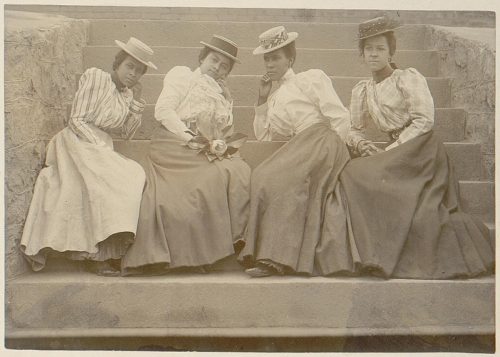
Four African American women in 1899, two years before Rebecca Perot died (Library of Congress)
___
Related links:
William Dorsey Swann: Ex-slave fought for queer freedom in 1880s as America’s first drag queen
Saint Walatta Petros: African nun shared a lifetime bond with a female partner in 17th-century
Grant-Michael Fitzgerald: Pioneering black gay Catholic brother advocated LGBTQ rights in 1970s
___
Top image credit:
“The Two Rebeccas” by Jeremy Whitner. Prints are available at Whitner’s Fine Art America shop.
___
This post is part of the LGBTQ Saints series by Kittredge Cherry. Traditional and alternative saints, people in the Bible, LGBT and queer martyrs, authors, theologians, religious leaders, artists, deities and other figures of special interest to lesbian, gay, bisexual and transgender and queer (LGBTQ) people and our allies are covered.
This article was originally published in March 2019 and was updated for accuracy and expanded with new material on May 23, 2025.
Copyright © Kittredge Cherry. All rights reserved.
Qspirit.net presents the Jesus in Love Blog on LGBTQ spirituality.

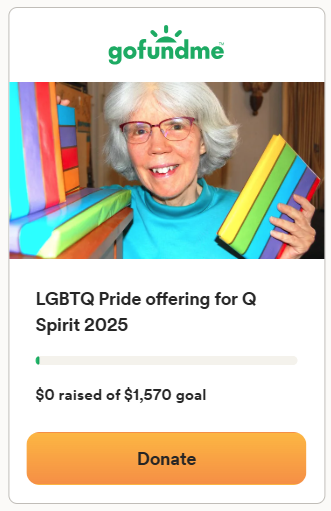


















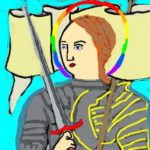
Excellent post, Kittredge! A well written, informative essay on these two incrdible women who happened to live right around the corner from where I now live in Philadelphia.